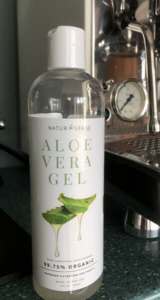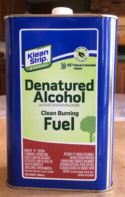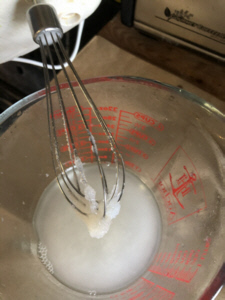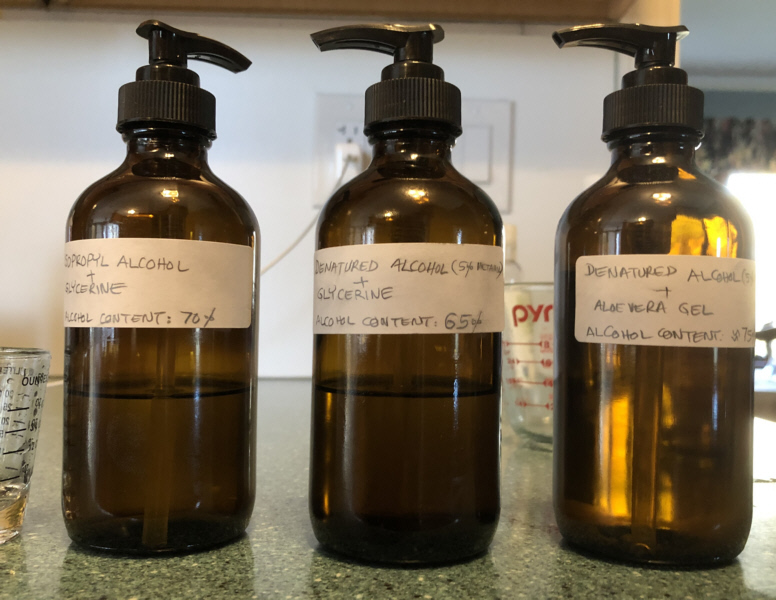Quest for a functional hand sanitizer to fight the pandemic
Please read the disclosures and disclaimers at the end of this document.
While reviewing our stockpile of essentials at the onset of the corona virus epidemic we noticed that we didn't have any disinfecting wipes
or hand sanitizers. We normally do not keep these items at home. We didn't think of these as essential items until the experts in
Geneva and Washington, DC declared a global pandemic after downplaying the threat for at least two months. But it was too late for us.
These items were nowhere to be found on store shelves or popular online sites.
We soon started working on home-made solutions. My wife created disinfecting wipes using paper towels soaked in isopropanol, water, and detergent.
Isopropanol and paper towels are two items we had stocked up in February, well before the panic became widespread.
My wife organized the pile of home-made wipes so effectively that it looked and worked better than mass-produced ones.
There are numerous articles on the Web with recipes and instructions for home-made hand sanitizers.
They all have two basic ingredients: alcohol and a thickening agent.
 Aloe vera gel is the commonly cited thickening agent.
Luckily, it was available online. It took just a couple of days for a bottle of the gel to arrive.
Aloe vera gel is the commonly cited thickening agent.
Luckily, it was available online. It took just a couple of days for a bottle of the gel to arrive.
I organized the ingredients and tools on the workbench in our garage. I immediately faced the first obstacle.
CDC recommends a minimum of 70% isopropanol content for the final product.
I noticed that the isopropanol we had in stock was of 70% concentration. There was no room for adding a thickening agent.
I need higher strength isopropanol. It's sold in 91% or 99% concentrations.
I soon discovered that alcohol in any concentration was unavailable in stores, both physical and online.
Two stores within a 10-mile area listed 91% isopropanol in stock, but when I went to the the first store I was told that the
information on the web wasn't accurate and that
they did not have any alcohol in stock. I proceeded to the second store, hoping for better luck.
And the experience there was the same.
I decided to do a bit more in-depth research on hand sanitizers.
You can use either ethanol or isopropanol to make hand sanitizers. Both CDC and WHO have plenty of technical information,
but their websites are not written for the average consumer. They have all kinds of technical terms and disclaimers.
The WHO site is designed for use by small factories and it forbids home users from making the product.
My next search was for high-concentration ethanol. Unfortunately, ethanol was out-of-stock in drug stores and online sources.
Given the ubiquity of ethanol, I was confident that I could procure ethanol somewhere.
The first idea was to try a liquor store which are all open since our governor declared liquor stores as essential businesses.
But there are many more sources for ethanol.
Ethanol is used as a paint stripper and solvent for home improvement jobs.
I decided to visit the local Home Depot.
 Sure enough Home Depot had denatured ethanol in stock. I had to refresh my memory of the meaning of the term "denatured".
It means the addition of a toxic or bad-tasting ingredient such as methanol to make the product unsuitable for human consumption.
I found two versions of denatured ethanol at the store. One was labeled as Green which had 5% methanol content.
The regular product had 50% methanol content.
Sure enough Home Depot had denatured ethanol in stock. I had to refresh my memory of the meaning of the term "denatured".
It means the addition of a toxic or bad-tasting ingredient such as methanol to make the product unsuitable for human consumption.
I found two versions of denatured ethanol at the store. One was labeled as Green which had 5% methanol content.
The regular product had 50% methanol content.
I bought the Green version of denatured ethanol with the assumption that 5% Methanol content wouldn't be harmful if
I didn't suck my thumb after applying the finished product on my hands.
I checked with my friend Ken, who has a Chemistry background. He suggested that I consult a toxicology website.
I concluded that it's safe enough to use the Green variety of denatured ethanol for the purpose of making hand sanitizer.
I shared my initial findings with my friend Dale. He was amazed at my lack of knowledge of high-concentration ethanol. He told
me about Everclear 190, the not-so-well-kept secret among fraternity members in the US.
 He also gave me a tutorial on the difficulty of refining ethanol at concentrations higher than 95%.
He has a far better memory of the subject from undergraduate days. Alcohol and water form a constant-boiling-point mixture called an azeotrope
at about 95% concentration. 95% concentration is 190 Proof in the liquor industry. Per Dale's suggestion, I called my local liquor store.
They had a couple of one-litre bottles of Everclear-190 left in stock. I put on my home-made cloth mask and made a quick trip to the liquor store
before they ran out of this precious commodity.
He also gave me a tutorial on the difficulty of refining ethanol at concentrations higher than 95%.
He has a far better memory of the subject from undergraduate days. Alcohol and water form a constant-boiling-point mixture called an azeotrope
at about 95% concentration. 95% concentration is 190 Proof in the liquor industry. Per Dale's suggestion, I called my local liquor store.
They had a couple of one-litre bottles of Everclear-190 left in stock. I put on my home-made cloth mask and made a quick trip to the liquor store
before they ran out of this precious commodity.
I was ready to go back to my workbench with all the necessary ingredients. As soon as I mixed ethanol and aloe vera gel I realized that
aloe vera gel is immiscible with alcohol. I spent a half hour with a spoon and a whisk,
but the aloe vera gel refused to blend in to form a usable product.
 A very small portion of the gel dissolved in alcohol. Most of the gel formed a viscous precipitate.
I filtered out the precipitate and bottled the alcohol for interim use while I researched a solution to the miscibility problem. I have no idea why so
many articles on the web recommend using aloe vera gel. Aloe vera is a natural product. People attribute all kinds of beneficial properties to it.
But, it just doesn't blend with alcohol and, therefore, it is virtually useless as an ingredient for making hand sanitizer at home.
Perhaps there is a secret ingredient that enables aloe vera to blend well with alcohol, but none of the articles on the web mentioned it.
A good lesson regarding unreliable or unverified information circulating on the web and social media.
A very small portion of the gel dissolved in alcohol. Most of the gel formed a viscous precipitate.
I filtered out the precipitate and bottled the alcohol for interim use while I researched a solution to the miscibility problem. I have no idea why so
many articles on the web recommend using aloe vera gel. Aloe vera is a natural product. People attribute all kinds of beneficial properties to it.
But, it just doesn't blend with alcohol and, therefore, it is virtually useless as an ingredient for making hand sanitizer at home.
Perhaps there is a secret ingredient that enables aloe vera to blend well with alcohol, but none of the articles on the web mentioned it.
A good lesson regarding unreliable or unverified information circulating on the web and social media.
More research and reliance on Chemistry led to a potential solution.
 The WHO recipe lists glycerin as a humectant.
I had to look up this technical term. It means a substance that helps to retain moisture.
I decided to research miscibility of glycerol and ethanol before proceeding with a trial.
Glycerol is miscible with both ethanol and isopropanol at room temperature and pressure. Now I was getting somewhere.
Glycerol is readily available. I was able to procure a small bottle in a couple of days.
The WHO recipe lists glycerin as a humectant.
I had to look up this technical term. It means a substance that helps to retain moisture.
I decided to research miscibility of glycerol and ethanol before proceeding with a trial.
Glycerol is miscible with both ethanol and isopropanol at room temperature and pressure. Now I was getting somewhere.
Glycerol is readily available. I was able to procure a small bottle in a couple of days.
Back to my workbench; I was finally able to produce a usable hand sanitizer by mixing ethanol and glycerine in appropriate proportions
to yield a minimum ethanol concentration of 60% as specified by the CDC. Meanwhile, my wife discovered that
we had a small supply of 91% isopropanol in our inventory.
So, I made two versions of hand sanitizer: ethanol-based and isopropanol-based.
(CDC specifications require a minimum of 70% alcohol contnet the iosopropanol version of the finished product).
I added a couple of drops of Lavender essential oil to blunt the alcohol odor. The finished product had a nice feel on the skin,
probably due to the glycerine content. I got a few glass squirt bottles to store the finished product.
My home-made version is not as viscous as Purell, but it works well for use both at home and in the car.

Finished Products
Disclosures and Disclaimer:
This is a description of observations from my experimental efforts. I undertook this in part to relieve the boredom of being shelterd at home.
We rarely go out during the pandemic period and, therefore, we don't have a compelling need for hand sanitizer.
Of course it's good to have a bottle in my car for an occasional situation when
I don't have access to soap and water for washing my hands. You will have to do your own math (stoichiometry) and measurements
in order to ensure that the final product has minimum-required alcohol content to kill the dreaded corona virus. Please consult CDC website.
I used an appropriate margin of safety for alcohol content. Using an alcohol-meter is the right way to ensure that the finished product meets
the minimum requirement. You should also note that denatured ethanol is toxic. Neither CDC nor WHO recommends the use of denatured alcohol
for the manufacure of hand sanitizer. I used it because of unavailability of regular alcohol (before I was made aware of Everclear-190).
All high-concentration alcohols are flammable.
If you have comments or suggestions, or would like to share your experience with me, please
write to jmec21@gmail.com
April, 2020
Home
 Aloe vera gel is the commonly cited thickening agent.
Luckily, it was available online. It took just a couple of days for a bottle of the gel to arrive.
Aloe vera gel is the commonly cited thickening agent.
Luckily, it was available online. It took just a couple of days for a bottle of the gel to arrive.
 Sure enough Home Depot had denatured ethanol in stock. I had to refresh my memory of the meaning of the term "denatured".
It means the addition of a toxic or bad-tasting ingredient such as methanol to make the product unsuitable for human consumption.
I found two versions of denatured ethanol at the store. One was labeled as Green which had 5% methanol content.
The regular product had 50% methanol content.
Sure enough Home Depot had denatured ethanol in stock. I had to refresh my memory of the meaning of the term "denatured".
It means the addition of a toxic or bad-tasting ingredient such as methanol to make the product unsuitable for human consumption.
I found two versions of denatured ethanol at the store. One was labeled as Green which had 5% methanol content.
The regular product had 50% methanol content.
 He also gave me a tutorial on the difficulty of refining ethanol at concentrations higher than 95%.
He has a far better memory of the subject from undergraduate days. Alcohol and water form a constant-boiling-point mixture called an azeotrope
at about 95% concentration. 95% concentration is 190 Proof in the liquor industry. Per Dale's suggestion, I called my local liquor store.
They had a couple of one-litre bottles of Everclear-190 left in stock. I put on my home-made cloth mask and made a quick trip to the liquor store
before they ran out of this precious commodity.
He also gave me a tutorial on the difficulty of refining ethanol at concentrations higher than 95%.
He has a far better memory of the subject from undergraduate days. Alcohol and water form a constant-boiling-point mixture called an azeotrope
at about 95% concentration. 95% concentration is 190 Proof in the liquor industry. Per Dale's suggestion, I called my local liquor store.
They had a couple of one-litre bottles of Everclear-190 left in stock. I put on my home-made cloth mask and made a quick trip to the liquor store
before they ran out of this precious commodity.
 A very small portion of the gel dissolved in alcohol. Most of the gel formed a viscous precipitate.
I filtered out the precipitate and bottled the alcohol for interim use while I researched a solution to the miscibility problem. I have no idea why so
many articles on the web recommend using aloe vera gel. Aloe vera is a natural product. People attribute all kinds of beneficial properties to it.
But, it just doesn't blend with alcohol and, therefore, it is virtually useless as an ingredient for making hand sanitizer at home.
Perhaps there is a secret ingredient that enables aloe vera to blend well with alcohol, but none of the articles on the web mentioned it.
A good lesson regarding unreliable or unverified information circulating on the web and social media.
A very small portion of the gel dissolved in alcohol. Most of the gel formed a viscous precipitate.
I filtered out the precipitate and bottled the alcohol for interim use while I researched a solution to the miscibility problem. I have no idea why so
many articles on the web recommend using aloe vera gel. Aloe vera is a natural product. People attribute all kinds of beneficial properties to it.
But, it just doesn't blend with alcohol and, therefore, it is virtually useless as an ingredient for making hand sanitizer at home.
Perhaps there is a secret ingredient that enables aloe vera to blend well with alcohol, but none of the articles on the web mentioned it.
A good lesson regarding unreliable or unverified information circulating on the web and social media.
 The WHO recipe lists glycerin as a humectant.
I had to look up this technical term. It means a substance that helps to retain moisture.
I decided to research miscibility of glycerol and ethanol before proceeding with a trial.
Glycerol is miscible with both ethanol and isopropanol at room temperature and pressure. Now I was getting somewhere.
Glycerol is readily available. I was able to procure a small bottle in a couple of days.
The WHO recipe lists glycerin as a humectant.
I had to look up this technical term. It means a substance that helps to retain moisture.
I decided to research miscibility of glycerol and ethanol before proceeding with a trial.
Glycerol is miscible with both ethanol and isopropanol at room temperature and pressure. Now I was getting somewhere.
Glycerol is readily available. I was able to procure a small bottle in a couple of days.
